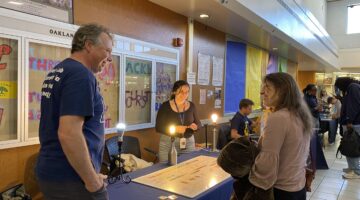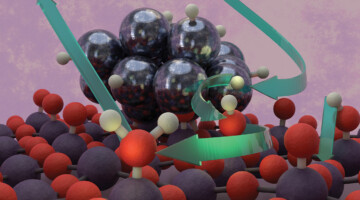Researchers found a way to turn single-use plastics (e.g., grocery bags and packaging) into useful liquid fuels, like components of gasoline or diesel, without needing high heat, rare metals, or added chemicals. The work presents a promising pathway to address the global plastic waste crisis, with both environmental and economic advantages. Read more »
All News & Updates
A New Twist for Superconductivity in Bilayer Graphene
In a study of twisted bilayer graphene (TBG) systems, researchers found intriguing spectroscopic features in a superconducting “magic-angle” TBG—features that are absent in non-superconducting TBG. The results provide crucial information on superconductivity in magic-angle TBG for next-gen electronics and advanced energy technologies. Read more »![]()
![]()
2025 User Meeting Registration is Open
August 11–13, 2025: Join us in person at the DoubleTree at Berkeley Marina for the Advanced Light Source User Meeting. Register by July 28 to take part in talks, poster slams, hands-on workshops, tutorials, and an exhibitor fair with refreshments. Read more »
ALS Captures Structure of Engineered Protein, Opening New Options to Treat IBD
Researchers use the ALS to confirm the structure of an engineered immune protein that could open new opportunities to treat inflammatory bowel disease. Read more »
Springer Nature Awards for Hendrik Ohldag
Staff Scientist Hendrik Ohldag has received two awards from Springer Nature in recognition of his contributions to npj Spintronics. Congratulations, Hendrik! Read more »
Catalysts Get a Boost with Atomic-Level Tinkering
A research team led by Berkeley Lab designed and fabricated catalysts by precisely tuning the co-localization of active metals—key catalytic centers for specific steps in reaction pathways—offering a new level of control over catalytic performance. Read more »
ALS-United: Don MacGill, Matt Warren, and Kyle McCombs
ALS-United is an opportunity to meet the people collaborating at the Advanced Light Source and the ALS Upgrade Project. Hear firsthand how team science enables the cutting-edge research of today and builds the facility of the future. This month, we spoke with Don MacGill (ALS Mechanical Technician Supervisor), Matt Warren (ALS Mechanical Technician Supervisor), and Kyle McCombs (ALS Mechanical Technology Group Lead). Read more »
Oakland Unified School District (OUSD) STEM Fair
Berkeley Lab returned to the OUSD STEM Fair in Oakland, offering a hands-on activity where students and their parents learn about the electromagnetic spectrum. The Lab’s booth was staffed by ALS staff members, Gianna Fazioliu, Ian Lacey, and Ina Reichel. Read more »
Catching “Hydrogen Spillover” onto a Catalytic Surface
Researchers uncovered the precise mechanism of hydrogen spillover (H2 splitting and migration) onto a catalytic surface by watching it happen under various conditions. The research lays the foundation for designing more efficient catalysts and storage materials essential for next-generation hydrogen energy technologies. Read more »![]()
![]()
Bringing Discoveries to Light: Six Ways the Advanced Light Source Is Accelerating Technology Breakthroughs for Society
For over 30 years, the Advanced Light Source has provided powerful x-ray, ultraviolet, and infrared light, enabling breakthroughs in batteries, semiconductors, quantum materials, drug discovery, and more. We continue to achieve significant milestones that have advanced science and technology for the benefit of society. Read more »
- « Previous Page
- 1
- 2
- 3
- 4
- 5
- 6
- …
- 139
- Next Page »









